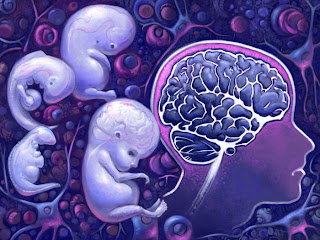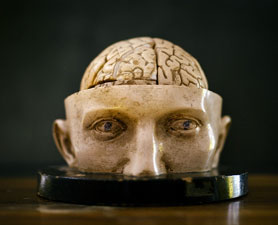What is a “neurodevelopmental disorder”?

This question arose at the recent, excellent meeting of the International Society for Developmental Neuroscience in Estoril, Portugal. The question came up due to some very exciting and very unexpected successes in reversing in adult animals the effects of mutations causing neurodevelopmental disorders, including neurofibromatosis, Down syndrome, Rett syndrome and tuberous sclerosis.
All of these disorders are caused by specific genetic lesions and characterised by very early deficits, variously including intellectual disability, autism, epilepsy and other psychological and neurological phenotypes. They are also associated with some degree of neuropathology, usually involving differences in the elaboration of neuronal morphology, branching and connectivity. Because of the early onset of symptoms, these disorders have traditionally been considered as being due to defects in neurodevelopment that have led to a permanently structurally compromised brain. The last thing most people would have expected is that many of the cognitive deficits in these disorders would be reversible in adults, by either restoring normal gene function or by compensating for the effects of the genetic lesion.
These lesions can be modeled in mice, often very directly, by knocking out the homologous gene, by introducing the human disease-causing mutation into the mouse gene or, for Down syndrome, by transgenically increasing the copy number of all the genes corresponding to human chromosome 21. For all these syndromes, genetically engineered mice display a range of cognitive phenotypes, correlated with alterations in the physiology of individual neurons and circuits. They thus provide invaluable models to investigate the mechanisms of disease and develop and test possible therapeutic approaches.
Rett syndrome is caused by mutations in MeCP2, which encodes a protein that binds to methylated DNA and controls gene expression. Such mutations are lethal in males, who have only one copy of this X-chromosomal gene, while girls inheriting the mutation develop a syndrome of intellectual disability, autism and sometimes epilepsy. MeCP2 mutations are also lethal in male mice, though they survive for some time and show severe behavioural defects, while females show a milder phenotype. These defects were assumed to be due to the absence of MeCP2 function during neurodevelopment and were therefore expected to be irreversible by subsequent restoration of MeCP2 activity.
However, reversal was exactly what was observed when the MeCP2 gene was turned on again from a transgene in adult mice. Lethality in males was completely rescued (not, as Adrian Bird said, after the fact), and defects in both sexes in synaptic plasticity underlying memory (long-term potentiation) and in behavioural measures of memory were all essentially completely reversed. Even more remarkable, reductions in size of particular neurons (parvalbumin-positive interneurons), in the thickness of the cortex and in the density of dendritic spines (reflecting the number of synaptic connections) were all also reversed. These results argue that Rett syndrome is less a disorder of neurodevelopment and more a disorder of aberrant neuronal maintenance.
Results for neurofibromatosis, tuberous sclerosis and Down syndrome were all similar, though in these cases, reversal was achieved in adults by pharmacologically compensating for the effects of the genetic lesions. By mutating the gene responsible for neurofibromatosis, NF1, specifically in distinct classes of neurons in mice, Alcino Silva and colleagues had found that the effects of this mutation on physiology and behaviour were only observed when NF1 was deleted in inhibitory interneurons. This led to an increase in the activity of these neurons, and a concomitant decrease in the activity of excitatory neurons. By blocking the receptors of inhibitory neurotransmission using picrotoxin, it was possible to restore the correct balance of inhibition and excitation in adults and to reverse the effects on physiology and behaviour. As with Rett syndrome, the effects of the NF1 mutation were thus not as permanent as expected.
Down syndrome model mice showed a similar effect: an increase in inhibitory neurotransmission, correlated with defects in long-term potentiation and performance in cognitive tasks. As with neurofibromatosis, blocking inhibitory receptors in adults caused remarkable rescue of these defects. Working out the nature of the biochemical defect in tuberous sclerosis also suggested a mechanism by which to reverse the effects in adults, which worked equally well.
These successes have been remarkable not just for how unexpected they were but also for how substantial the improvement is in adult animals when normal gene function is restored or the biochemical or physiological defect is compensated for. The results obviously offer great promise for effective therapeutic intervention in patients and some of the approaches are already in small-scale clinical trials. As in all such situations, however, translation to humans will be slow and difficult and miracle cures are unlikely to emerge in the near future.
Do these principles apply to all neurodevelopmental disorders? It is unlikely. Indeed, many other disorders not previously classified as neurodevelopmental may have to be re-evaluated as such. One of these is schizophrenia. While the symptoms of this disease do not usually emerge until late adolescence, there is very good evidence that they stem from earlier insults in neurodevelopment. This is supported by additional modeling of schizophrenia-associated mutations in mice, including mutations in the gene DISC1. DISC1 mutations cause a range of schizophrenia-related behavioural phenotypes in mice. Remarkably, disruption of the activity of DISC1 just during development is sufficient to induce these phenotypes in adults, even though normal gene function was subsequently restored. In this case, defects in neurodevelopment can thus not be reversed in adults.
Perhaps neurodevelopmental disorders should be defined as such not so much on when the symptoms arise but on the timing of the requirement for gene function.
EHNINGER, D., LI, W., FOX, K., STRYKER, M., & SILVA, A. (2008). Reversing Neurodevelopmental Disorders in Adults Neuron, 60 (6), 950-960 DOI: 10.1016/j.neuron.2008.12.007



Hi Kevin,
ReplyDeleteThank you for the informative report of what sounded like an excellent meeting.
I think it is clear that the fact that a given disorder emerges during development is not sufficient evidence for the disorder to be classed as developmental. But it seems that there's a flip side to the coin of reversibility (which you touched on with the DISC1 example). It seems to me that disorders that can be rescued in adulthood cannot be excluded from the developmental category straight away. It must also be established that the disease phenotype requires loss of function during development. So, even though mouse models of Rett syndrome and the other examples can be rescued by adulthood expression of the missing gene, the question remains did the mutant phenotype originate because of absence of the gene during development in the first place.
The experiment to answer this question would probably be to delete MeCP2 only after adulthood is reached, and see whether or not the disease phenotype occurs. If it does, then it’s not developmental, if it doesn't, then it is developmental, but for some reason can also be rescued in adulthood.
Loss of the NMDA receptor NR1 subunit in cortico-hippocampal interneurons during postnatal development results in schizophrenia-like symptoms (Belforte et al '10 Nat Neuro). But this group tested whether adult deletion of NR1 caused the same effect, and demonstrated that indeed it did not. They did not report an adult reversal experiment, but regardless of whether or not the symptoms can be reversed by adult expression of NR1, the disorder is surely developmental. So I think your definition of the timing of requirement of gene function certainly seems the most reasonable/accurate definition.
Therefore if we can reverse these things in adults – great! and the Biotech companies will be throwing more resources at developing those solutions than any academic institution could. But either way if the disorder originates during development , then that is where fundamental science might still want concentrate a good deal of its research, and where preventative efforts by educational and health-care professionals might prove most useful for humans.
I’ve seen these kinds of businesses on TV, radio and on the internet and I never really believed that you can actually be truly successful and always thought that it wasn’t a career. When my friend endorsed Purity 12 to me, I definitely gave her my piece and told her that you can’t gain anything from it and she’s just wasting her time and energy. But now, she’s laughing at me because I had to take it all back after trying one of their products. Now, I’m paying my apartment rent with the money I earn from Purity 12! It’s a great opportunity that I’m glad I didn’t miss. http://if1s.com?116
ReplyDeleteThe object itself is not worthy of so many applications of forces, because for the world of culture considered a secondary phenomenon and no artistic value is not.
ReplyDeletehelp writing college essays